Resources
In the face of a mounting mental health crisis among college students, professors have an opportunity and responsibility to respond to their students’ psychological distress. Psychological and historical scholarship suggests that the proliferation of modern media and breakdown in traditional sources of existential meaning like religion are significant factors in young adults’ declining mental health. In response to this crisis, this article examines the crucial role of the imagination in constructing meaning and proposes an imagination‐centered pedagogical process by means of which teachers can assist students in recovering meaning and integration in their lives.
Students increasingly appear anxious, risk‐averse, and worried about getting things “wrong.” They may appear to lack intellectual curiosity, and be unwilling to engage in independent study. This essay explores how teaching and assessment in theology and religious studies might help students learn to take intellectual risks, and increase their resilience. One approach is to encourage students to experiment and “fail safely,” to increase their confidence that they understand what is expected of them, and to help them begin to understand learning as more broadly formational, not always directed toward a grade. I suggest three strategies: more formative assessment; a stronger narrative about the purpose of formative assessment; and an appeal to values, virtue, and the cultivation of character. Via these approaches, students might be encouraged to understand assessment in less utilitarian terms and increase their resilience for a world characterized by volatility, uncertainty, complexity, and ambiguity, prepared both critically and dispositionally to thrive and contribute positively to society.
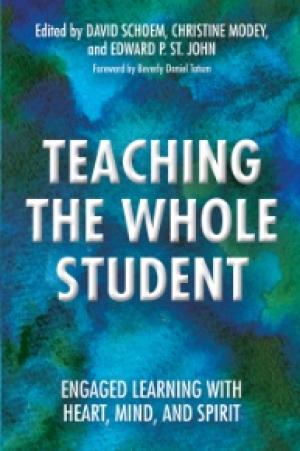
Click Here for Book Review Teaching the Whole Student is a compendium of engaged teaching approaches by faculty across disciplines. These inspiring authors offer models for instructors who care deeply about their students, respect and recognize students’ social identities and lived experiences, and are interested in creating community and environments of openness and trust to foster deep-learning, academic success, and meaning-making. The authors in this volume stretch the boundaries of academic learning and the classroom experience by seeking to identify the space between subject matter and a student's core values and prior knowledge. They work to find the interconnectedness of knowledge, understanding, meaning, inquiry and truth. They appreciate that students bring their full lives and experiences—their heart and spirit—into the classroom just as they bring their minds and intellectual inquiry. These approaches contribute to student learning and the core academic purposes of higher education, help students find meaning and purpose in their lives, and help strengthen our diverse democracy through students’ active participation and leadership in civic life. They also have a demonstrated impact on critical and analytical thinking, student retention and academic success, personal well-being, commitments to civic engagement, diversity, and social justice. Topics discussed: • Teacher-student relationships and community building • How teaching the whole student increases persistence and completion rates • How an open learning environment fosters critical understanding • Strategies for developing deep social and personal reflection in experiential education and service learning The authors of this book remind us in poignant and empirical ways of the importance of teaching the whole student, as the book's title reflects. (From the Publisher)
An extended metaphor for teaching. This essay draws out the useful parallels between the best kind of teacher and the Good Witch of the North, Glinda, from The Wizard of Oz. Unappealing to many viewers or readers of the classic children's story, Glinda offers an inspiring reminder of four important pedagogical points: (1) the master teacher always treats her student as a peer; (2) the master teacher acknowledges and encourages her student's abilities but lets her learn how to exercise them on her own; (3) the master teacher is often not equivalent or even similar to anyone the student has encountered before; and (4) the master teacher is not a surrogate parent but a more distant figure.
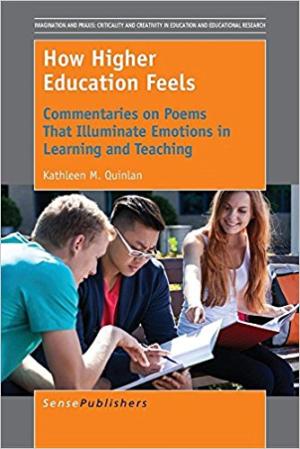
Click Here for Book Review Teaching and learning in higher education can evoke strong feelings, including confusion, anxiety, boredom, curiosity, surprise and exhilaration. These emotions affect students’ learning, progress and overall success. Teachers’ emotions affect how they teach and their relationships and communication with students. Yet the emotional dimensions of teachers’ and students’ experiences are rarely discussed in the context of improving higher education. This book addresses that gap, offering short, evocative case studies to spark conversation among university teachers. It challenges readers to reflect on how higher education feels, to explore the emotional landscape of courses and programmes they create and consider the emotional effects of messages embedded in various policies and practices. Following the student lifecycle from enrollment to reunion, each of the main chapters contains 10 to 15 accessible, emotionally-engaging poems that serve as succinct case studies highlighting how some aspect of learning, teaching or development in higher education feels. Each chapter also contains an expert scholarly commentary that identifies emergent themes across the cases and establishes connections to theory and practice in higher education. The poems-as-case-studies are ideal for use in faculty or educational development workshops or for individual reflection. A variety of theoretical perspectives and associated reflection prompts provide lenses for variously interpreting the poems. An appendix offers suggestions for structuring case discussions as part of educational development activities. The book promotes a person-centered discourse, giving voice to previously neglected aspects of higher education and reminding us that education is essentially a human endeavor. (From the Publisher)
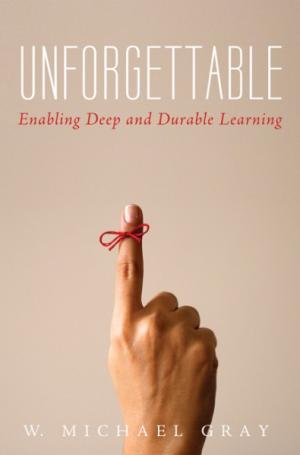
We have an uneasy relationship with the relentless deluge of information gushing out of academia and our media outlets. To turn it off is escapist, but to attempt to cognitively grapple with it is overwhelming. In Unforgettable: Enabling Deep and Durable Learning, a nationally recognized master teacher gives professors and their students the means to chart a clear path through this information explosion. Humans crave explanatory patterns, and this book enables teachers to think deeply about their academic disciplines to find and articulate their core explanatory principles and to engage their students in a compelling way of thinking. An alternative title for this book could be Why the Best College Teachers Do What They Do because the author articulates a compelling rationale that will equip faculty to create and deliver transformative courses. Students in transformative courses grapple with essential questions and gain mental muscle that equips them for real world challenges. (From the Publisher)
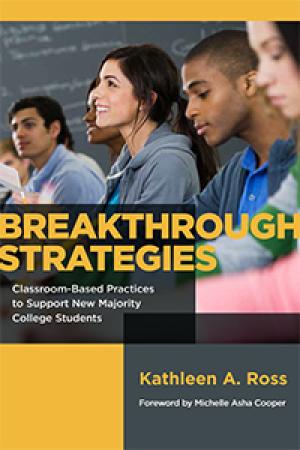
Click Here for Book Review Breakthrough Strategies identifies effective strategies that faculty have used to help New Majority students—those from minority, immigrant, or disadvantaged backgrounds—build the necessary skills to succeed in college. As the proportion of New Majority students rises, there is increased attention to helping them gain access to college. Once enrolled, however, these students often face significant challenges of adjustment, with few resources for support. Specifically, there is little attention to students’ experiences within their college classrooms and their relationships with professors. At the same time, faculty who work with these students have little guidance on how to help them adjust to new expectations and identities as they engage with college-level work. Sister Kathleen A. Ross, a MacArthur fellow and president emerita of Heritage University, has devoted three decades to helping New Majority students get college degrees. Based on an action-research project undertaken at Heritage University and Yakima Valley Community College in Washington State, the book highlights eleven strategies to encourage student success, including: asking questions in class; navigating the syllabus; and developing an academic identity. Written in a warm, down-to-earth voice, Breakthrough Strategies is infused with the belief that faculty can become a powerful resource for students, and that classroom instruction can be an important vehicle for supporting these students’ development and success. (From the Publisher)
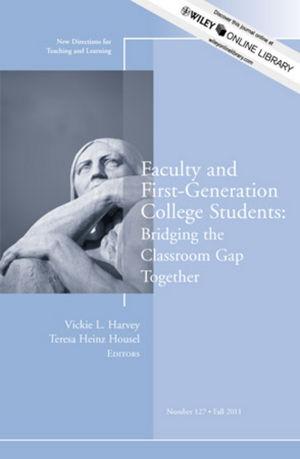
Gain a greater understanding of the academic, cultural, and social experiences of first-generation college students (FGS). Fascinating, heart-touching, and important, the research and the stories presented here enlighten what FGS often have to overcome to successfully complete their degrees. With an emphasis on improving FGS' college success, retention, and graduation rates, this volume first covers common obstacles and the trend of FGS continuing on for graduate degrees. Section Two discusses the complex interplay of social, academic, emotional, and financial influences on academic performance. The chapters collectively affirm that the commitment of university resources is critical to college success. This is the 127th volume of the Jossey-Bass higher education quarterly report New Directions for Teaching and Learning, which offers a comprehensive range of ideas and techniques for improving college teaching based on the experience of seasoned instructors and the latest findings of educational and psychological researchers. (From the Publisher)
Sexual violence on campus is a major issue facing students, faculty, and administrators, and institutions of higher education are struggling to respond. This forum brings together three responses to the problem, with a focus on the religious studies classroom. The responses move from the institution to the faculty to the classroom, exploring three separate but linked spaces for responding to sexual violence. The first contribution (Graybill) critiques common institutional responses to sexual violence. The second contribution (Minister) advocates for long-term, classroom-based responses to sexual violence and describes a faculty/staff workshop response. The third contribution (Lawrence) emphasizes the classroom, examining the issues that arise when perpetrators of sexual assault are part of the student body. Read together, the pieces offer a comprehensive view of the complicated intersections of sexual violence, the university, and pedagogical issues in religious studies.
In this article, I explore an ethical and pedagogical dilemma that I encounter each semester in my world religions courses: namely, that a great number of students enroll in the courses as part of their missionary training programs, and come to class understanding successful learning to mean gathering enough information about the world's religious “traditions” so as to effectively seduce people out of them. How should we teach world religions – in public university religious studies courses – with this student constituency? What are/ought to be our student learning goals? What can and should we expect to accomplish? How can we maximize student learning, while also maintaining our disciplinary integrity? In response to these questions, I propose a world religions course module, the goal of which is for students to examine – as objects of inquiry – the lenses through which they understand religion(s). With a recognition of their own lenses, I argue, missionary students become more aware of the biases and presumptions about others that they bring to the table, and they learn to see the ways in which these presumptions inform what they see and know about others, and also what they do not so easily see.